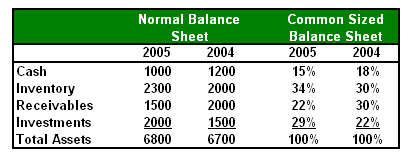Vertical Analysis
A method of financial statement analysis in which each entry for each of the three major categories of accounts (assets, liabilities and equities) in a balance sheet is represented as a proportion of the total account. The main advantages of vertical analysis is that the balance sheets of businesses of all sizes can easily be compared. It also makes it easy to see relative annual changes within one business.
For example, suppose XYZ Corp. has three assets: cash and cash equivalents (worth $3 million), inventory (worth $8 million), and property (worth $9 million). If vertical analysis is used, the asset column will look like:
Cash and cash equivalents: 15%
Inventory: 40%
Property: 45%
This method of analysis contrasts with horizontal analysis, which uses one year's worth of entries as a baseline while every other year represents differences in terms of changes to that baseline.
Vertical analysis reports each amount on a financial statement as a percentage of another item. For example, the vertical analysis of the balance sheet means every amount on the balance sheet is restated to be a percentage of total assets.
Cash and cash equivalents: 15%
Inventory: 40%
Property: 45%
This method of analysis contrasts with horizontal analysis, which uses one year's worth of entries as a baseline while every other year represents differences in terms of changes to that baseline.
Vertical analysis reports each amount on a financial statement as a percentage of another item. For example, the vertical analysis of the balance sheet means every amount on the balance sheet is restated to be a percentage of total assets.

No comments:
Post a Comment